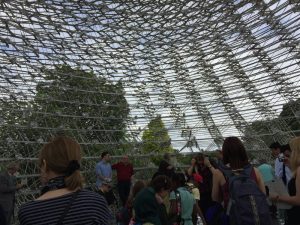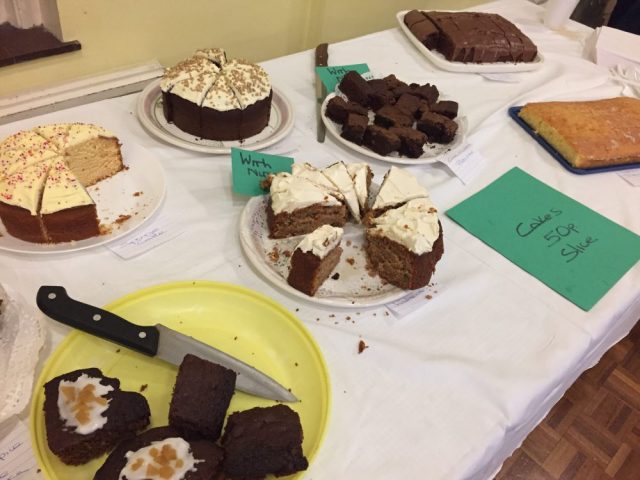On Saturday I went to the Federation of Middlesex Beekeepers’ Associations annual ‘Federation Day‘. Each year the Middlesex associations (Ealing, Enfield, Harrow, North London, Pinner & Ruislip) take it in turn to host a day of beekeeping talks; this year it was Ealing’s turn, which was nice as last year it took me nearly three hours to reach Enfield!
Unfortunately I could only stay for the first speaker, Dr Martin Bencsik. Martin is a Reader in Physics at Nottingham Trent University – we were lucky as he had travelled down from Nottingham to speak for us. His research focuses on novel applications of Magnetic Resonance Imaging (MRI) and more recently on bioacoustics, including honey bee colony condition monitoring. His use of accelerometers to measure vibrations in honey bee hives led him to become involved in The Hive artwork at Kew, supplying the measurement technology and software which animates the work.
Martin began by explaining that accelerometers are used to sense vibrations. People often confuse sounds and vibrations. For honey bees and most insects, sounds are actually probably irrelevant. Perhaps 70% of insects prefer vibrations to sounds for communicating (crickets are an exception). Like a mobile phone, small insects find it easier to produce efficient vibrations than sounds.
For his research he set up an apiary in France with an accelerometer in each hive. It takes a few seconds to implant each accelerometer in the comb, but it’s expensive – at £500 per accelerometer. He sent an accelerometer round the audience for us to look at, which he emphasised he definitely wanted back! The technology has revealed some fascinating insights, particularly around swarming. The accelerometer picks up the sound of the swarm preparing to leave as the bees become so excited their vibrations shake the comb. Martin played us an amazing recording of a primary swarm from 20 minutes beforehand up to the moment of departure (condensed into a shorter clip, not the full 20 minutes). The buzzing filled the room as if we were inside the hive – it was quite intense and everyone clapped after it finished.
Martin mentioned that he has recorded the old queen piping before she swarms. This has happened twice in thirty primary swarms he’s recorded, so is fairly rare but shows it’s not just virgin queens that pipe. The time of day of the primary swarm has always been between 11am-3pm, but usually nearer 11 than 3.
Some swarm definitions:
- Primary swarm = the first swarm to leave the parent colony, usually with the old queen.
- Secondary swarm = a smaller swarm after the primary swarm has left, containing one or more virgin queens. Also called an ‘afterswarm’ or ‘cast’ swarm.
As well as putting the accelerometers in the comb, Martin has tried putting them in the brood box walls. However, the wood has different resonances that affects measurement, whereas comb is very stable and soft, so measurements from accelerometers in comb are more reliable. External sounds like planes, wildlife, birds etc can also affect the accelerometers placed in the brood box walls and drown out the vibrations of the bees. It is commercially appealing to put accelerometers in brood boxes though, as they might sell well.
He went on to tell us a little about how Wolfgang Buttress produced The Hive installation – see my post ‘The Hive at Kew‘ for more about this. I was impressed to hear that every cell in its lattice is different and each layer has been cut slightly differently, to a budget of £8m. Kew are now hoping to keep the installation until 2020, as visitor numbers are up since they hired it.
In response to a question on his future research, Martin revealed that he hopes to secure further funding for his work on honey bee monitoring. He feels passionate about directing his work towards helping bees and the environment, as he has become tired of the selfish actions of humans and the effect we have on the natural world. Ingenious and clever though humans are, so often we destroy all that is beautiful.
I hope everyone enjoyed the Federation day. I know a lot of hard work went into it by people such as Clare, Elsa, Sue, Jonesy, Andy, Tom and many others. Below is the cake table, which was very popular!




It is so interesting to see all the people involved in the Kew installation, hope it stays around long enough for me to see it. No idea when/if I might get to England again so I love reading about the work and people involved in the effort. What an interesting talk!
LikeLike
Thanks Erik! Hope you get to see it one day, maybe somewhere else if not at Kew.
LikeLiked by 1 person
Great information about swarming. I guess they are programmed to swarm in late morning no matter where they are. Ours tend to swarm around noon.
LikeLike
Interesting!
LikeLike
Pingback: Middlesex Federation Day: Dr Martin Bencsik – “Monitoring honeybee colony activity with accelerometer sensors” | How To Raise Bees
Hi Emily, first time commenter. Just wondering if you could elaborate on “People often confuse sounds and vibrations.” Would you agree that in this context “sound” is a sound wave travelling through the medium of air and that “vibration” is a sound wave travelling through some other medium, such as the wooden walls of a brood box?
Great article.
LikeLiked by 1 person
Thanks Drewber, nice to hear your thoughts for the first time. I would agree with your insightful analysis.
LikeLiked by 1 person
Pingback: Middlesex Federation Day: Dr Martin Bencsik – “Monitoring honeybee colony activity with accelerometer sensors” | Raising Honey Bees
it is so good to be kept up to date. It is fascinating to think that you have shared what it must feel like inside the hive. Amelia
LikeLike
I often like to imagine how it feels to be a bee. I was amazed to see both our colonies flying in fairly heavy rain today, a brave thing to do when you think how big raindrops are compared to a bee.
LikeLike
I have never noticed ours flying in the rain. The spring fever must overcome the danger of becoming sodden and must force them on. Amelia
LikeLike
I was worried that they were flying out of desperation as they are running low on stores. We tried to give the nucleus extra fondant but it’s a difficult to feed without squashing bees.
LikeLike
Fascinating science, the sophstication of bees and their societies is truly incredible.
LikeLike
Yes it is. I’m sure we have lots more to find out.
LikeLike
Thanks for the write up Emily – makes me feel I was there for the talk! 🐝🐝🐝
LikeLiked by 1 person